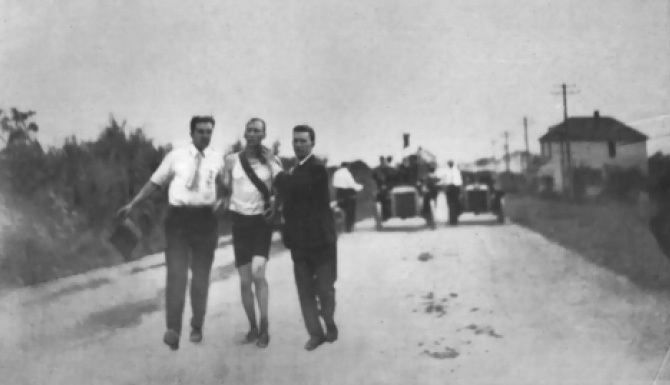Venue St. Louis Competitors 32 from 4 nations | Dates August 30 | |
 | ||
The men's marathon at the 1904 Summer Olympics in St. Louis took place on August 30 of that year, over a distance of 24.85 miles. Thirty-two athletes representing four nations competed, but only 14 managed to finish the race, which proved to be a bizarre affair due to poor organization and officiating.
Contents
Instead of having the marathon begin early in the morning, St. Louis organizers started it in the afternoon, and temperatures during the marathon reached 32 °C (90 °F). The race began and ended in the stadium, but the rest of the course was on dusty country roads with race officials riding in vehicles ahead of and behind the runners, creating dust clouds. The only source of water for the competitors was a well at about the 11-mile mark.
Records
These were the standing world and Olympic records (in hours) prior to the 1904 Summer Olympics.
(*) Distance was also 40 kilometres
Race
The first to arrive at the finish line was American runner Fred Lorz, who had actually dropped out of the race after nine miles and hitched a ride back to the stadium in a car, waving at spectators and runners alike during the ride. When the car broke down at the 19th mile, Lorz re-entered the race and jogged across the finish line. Hailed as the winner, he had his photograph taken with Alice Roosevelt, daughter of then-U.S. President Theodore Roosevelt, and was about to be awarded the gold medal when his subterfuge was revealed. Lorz immediately admitted what he'd done and said he had only been joking; the AAU responded by banning him from competition for life (although they reconsidered and lifted the ban a year later).
British-born Thomas Hicks of the United States ended up the winner of the event, although he was aided by measures that would not have been permitted in later years. Ten miles from the finish Hicks led the race by a mile and a half, but he had to be restrained from stopping and lying down by his trainers. From then until the end of the race, Hicks received several doses of strychnine sulfate (a common rat poison, which stimulates the nervous system in small doses) mixed with brandy. He continued to battle onwards, hallucinating, barely able to walk for most of the course. When he reached the stadium his support team carried him over the line, holding him in the air while he shuffled his feet as if still running. The judges decided this was acceptable, and gave him the gold medal. He never ran professionally again. Hicks had to be carried off the track, and might have died in the stadium had he not been treated by several doctors.
Another near-fatality during the event was William Garcia of San Francisco. He was found lying in the road along the marathon course with severe internal injuries caused by breathing the clouds of dust kicked up by the race officials' cars.
A Cuban postman named Andarín Carvajal joined the marathon, arriving at the last minute. After losing all of his money in New Orleans, Louisiana, he hitchhiked to St. Louis and had to run in street clothes for the event that he cut around the legs to make them look like shorts. Not having eaten in 40 hours, he stopped off in an orchard en route to have a snack on some apples, which turned out to be rotten. The rotten apples caused him to have strong stomach cramps. Despite falling ill from the apples he finished in fourth place.
The marathon included the first two black Africans to compete in the Olympics: two Tswana tribesmen named Len Tau (real name: Len Taunyane) and Yamasani (real name: Jan Mashiani). They were not in St. Louis to compete in the Olympics, however; they were actually part of the sideshow. They had been brought over by the exposition as part of the Boer War exhibit (both were really students from Orange Free State in South Africa, but this fact was not made known to the public). Len Tau finished ninth and Yamasani came in twelfth. This was a disappointment, as many observers were sure Len Tau could have done better if he had not been chased nearly a mile off course by aggressive dogs.
Arriving without correct documents, Frenchman Albert Corey was not included as part of the French team. He is inconsistently listed as performing in a mixed team in the four mile team race and performing for the US in the marathon.
